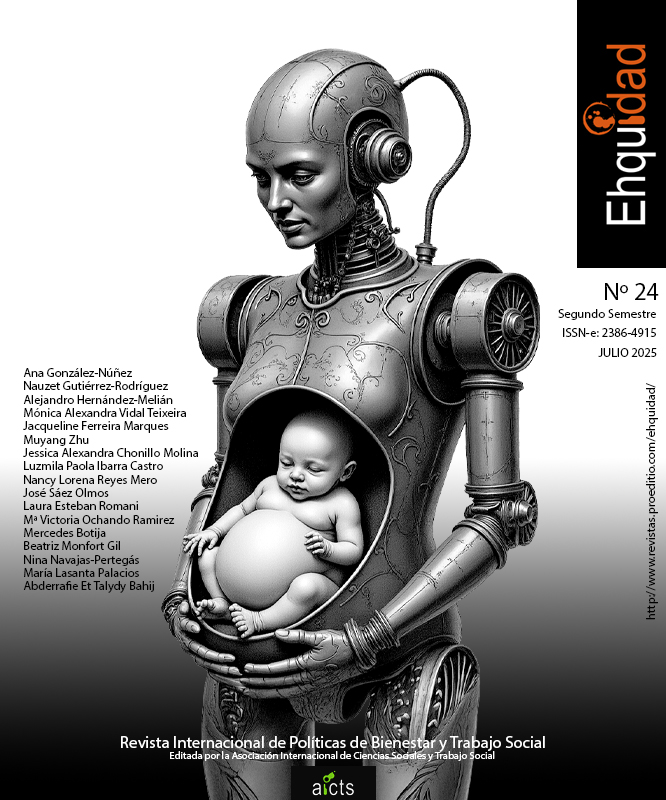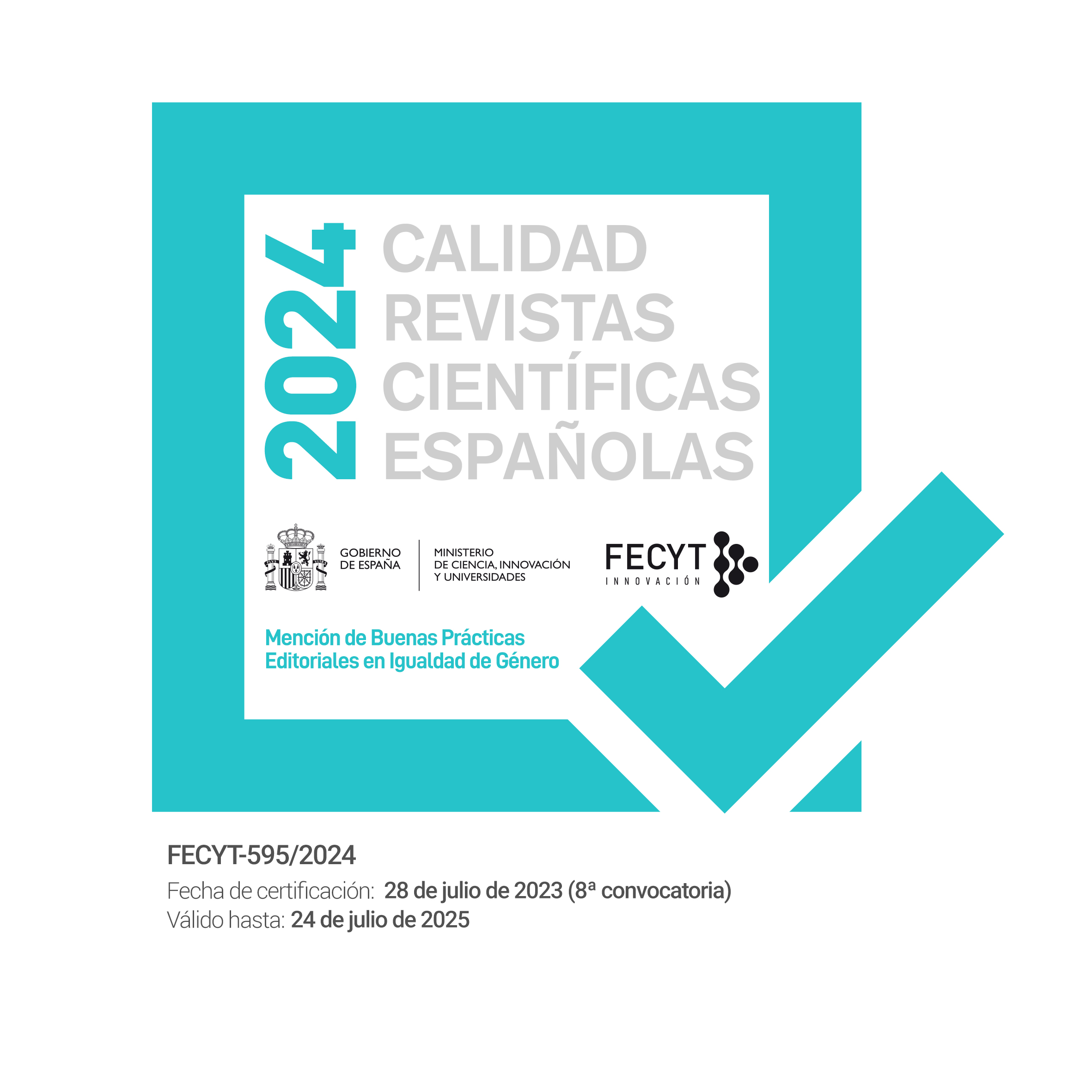Estudio exploratorio sobre experiencias de estigma de la gordura según las usuarias del sistema público de salud valenciano
DOI:
https://doi.org/10.15257/ehquidad.2025.0018Palabras clave:
Estigma de la gordura, Gordofobia médica, Maltrato médico, Desigualdades en salud, EspañaResumen
El estigma de la gordura (o gordofobia) está presente en diversos ámbitos sociales y vulnera los derechos humanos, especialmente, de las niñas y las mujeres. Esto puede resultar en discriminaciones que dañan su salud. Sin embargo, conocemos poco sobre dichas experiencias en el ámbito español e hispanoamericano. El propósito de esta investigación fue explorar el estigma de la gordura experimentado por usuarias sistema público de salud valenciano. Se usó un enfoque metodológico cualitativo. Partiendo de entrevistas realizadas a 26 mujeres, de entre 18 y 61 años, se realizó un análisis de tipo discursivo. El análisis sobre las vivencias de las mujeres gordas en el ámbito sanitario ofrecido se cuenta entre las escasas investigaciones realizadas al respecto en España e Hispanoamérica. Los resultados muestran que: a) las participantes experimentaron estigma de la gordura verbal comportamental y ambiental; b) encontraron barreras para obtener diagnósticos; c) soportaron violencia ginecológica y obstétrica basada en prejuicios gordofóbicos; d) y que dichas experiencias interfirieron en la búsqueda de ayuda. La atención sanitaria equitativa y no discriminatoria implica erradicar los fenómenos de estigma evidenciados. Las evidencias encontradas y las quince propuestas prácticas que se incluyen pueden orientar acciones y políticas públicas para humanizar la medicina y asegurar la salud y el bienestar de las personas gordas.
Descargas
Citas
An, R., Ji M. y Zhang S. (2018). Global warming and obesity: a systematic review. Obesity Reviews, 19(2), 150-163. https://doi.org/10.1111/obr.12624
Arguedas Ramírez, G. (2014). La violencia obstétrica: propuesta conceptual a partir de la experiencia costarricense. Cuadernos Inter.c.a.mbio sobre Centroamérica y el Caribe, 11(1), 145-169. https://doi.org/10.15517/c.a..v11i1.14238
Bacon, L., O’Reilly, C., y Aphramor, L. (2016). Reflections on Thin Privilege and Responsibility. En E. Cameron y C. Russell (Eds.): The Fat Pedagogy Reader. Challenging Weight-Based Oppression Through Critical Education (pp. 41-50). Peter Lang.
Bourdieu, P. (2000). La dominación masculina. Anagrama.
Braun, V., y Clarke, V. (2013). Successful qualitative research: A practical guide for beginners. SAGE.
Brüggemann, A., Wijma, B., y Swahnberg, K. (2012). Abuse in health care: a concept analysis. Scandinavian Journal of Caring Sciences, 26(1),123-132. https://doi.org/10.1111/J.1471-6712.2011.00918.X
Burgard, D. (2009). What is health at every size?. En E. Rothblum y S. Solovay (Eds.): The Fat Studies Reader (pp. 42-53). NYU Press.
Calogero, R., Tylka, T.L. y Mensinger, J.L. (2016). Scientific Weightism: A View of Mainstream Weight Stigma Research Through a Feminist Lens. En T.A. Roberts, N. Curtin, L. E. Duncan, y L.M. Cortina (Eds.): Feminist Perspectives on Building a Better Psychological Science of Gender (pp. 9-28). Springer.
Cárdenas Castro, M., Salinero Rates, S., y García Núñez, C. (2020). Escala de violencia ginecológica. Validación de una medida de abuso psicológico, físico y sexual contra las mujeres en el sistema de salud chileno. Revista de Obstetricia y Ginecología de Venezuela, 80(3),187-196. Disponible en: https://ir.uv.es/h1rugC0 (4 abril de 2025).
Cohen Shabot, S. y Korem, K. (2018). Domesticating Bodies: The Role of Shame in Obstetric Violence. Hypatia, 33(3), 384-401. https://doi.org/10.1111/HYPA.12428
Delahanty, L. M., Pan, Q., Jablonski, K. A., Aroda, V. R., Watson, K. E., Bray, G. A., Kahn, S. E., Florez, J. C., Perreault, L., & Franks, P. W. (2014). Effects of weight loss, weight cycling, and weight loss maintenance on diabetes incidence and change in cardiometabolic traits in the diabetes prevention program. Diabetes Care, 37(10), 2738–2745. https://doi.org/10.2337/DC14-0018
Ehrenreich, B. (2018). Natural Causes: An Epidemic of Wellness, the Certainty of Dying, and Killing Ourselves to Live Longer. Grand Central Publishing.
Eisenberger, N. I. (2012). The neural bases of social pain: Evidence for shared representations with physical pain. Psychosomatic Medicine, 74(2), 126. https://doi.org/10.1097/PSY.0B013E3182464DD1
Ennab, F., & Atiomo, W. (2023). Obesity and female infertility. Best Practice & Research Clinical Obstetrics & Gynaecology, 89, 102336. https://doi.org/10.1016/J.BPOBGYN.2023.102336
Euro-Peristat Project (2018). European Perinatal Health Report. Core indicators of the health and care of pregnant women and babies in Europe in 2015. Disponible en: https://ir.uv.es/1Oay5Py (4 abril de 2025).
Ferrante, J. M., Ohman-Strickland, P., Hudson, S. V., Hahn, K. A., Scott, J. G., & Crabtree, B. F. (2006). Colorectal cancer screening among obese versus non-obese patients in primary care practices. Cancer Detection and Prevention, 30(5), 459–465. https://doi.org/10.1016/j.cdp.2006.09.003
Fikkan, J. y Rothblum, E. (2012). Is Fat a Feminist Issue? Exploring the Gendered Nature of Weight Bias. Sex Roles, 66(9), 575-592. https://doi.org/10.1007/s11199-011-0022-5
Foucault, M. (2002). La arqueología del saber. Siglo veintiuno editores.
Franco, S., Barbanera, M., Moscetti, R., Cicatiello, C., Secondi, L., & Massantini, R. (2022). Overnutrition is a significant component of food waste and has a large environmental impact. Scientific Reports, 12(1), 1–11. https://doi.org/10.1038/s41598-022-11813-5
Gautam, D., Purandare, N., Maxwell, C. V., Rosser, M. L., O’Brien, P., Mocanu, E., McKeown, C., Malhotra, J., & McAuliffe, F. M. (2023). The challenges of obesity for fertility: A FIGO literature review. International Journal of Gynecology and Obstetrics, 160(S1), 50–55. https://doi.org/10.1002/IJGO.14538
Goffman, E. (2006). Estigma: la identidad deteriorada. Amorrortu.
Gudzune, K., Beach M.C., Roter, D.L. y Cooper, L.A. (2013). Physicians build less rapport with obese patients. Obesity, 2(10), 2146-2152. https://doi.org/10.1002/OBY.20384
Hall, S. (1992). The West and the Rest: Discourse and power. In S. Hall & B. Gieben (Eds.), Formations of Modernity (pp. 275–331). Polity Press.
Haraway, D. (1991). Ciencia, cyborgs y mujeres: la reinvención de la naturaleza. Cátedra.
Huizinga, M.M., Bleich, S.N., Beach, M.C., Clark, J.M. y Cooper, L.A. (2010). Disparity in physician perception of patients’ adherence to medications by obesity status. Obesity, 18(10), 1932-1937. https://doi.org/10.1038/OBY.2010.35
Jeong, H. G., Cho, S., Ryu, K. J., Kim, T., & Park, H. (2024). Effect of weight loss before in vitro fertilization in women with obesity or overweight and infertility: a systematic review and meta-analysis. Scientific Reports, 14(1), 1–9. https://doi.org/10.1038/S41598-024-56818-4
Lee, J. y Pausé, C. (2016). Stigma in practice: Barriers to health for fat women. Frontiers in Psychology, 7(DEC), 2063. https://doi.org/10.3389/fpsyg.2016.02063
Legro, R. S., Hansen, K. R., Diamond, M. P., Steiner, A. Z., Coutifaris, C., Cedars, M. I., Hoeger, K. M., Usadi, R., Johnstone, E. B., Haisenleder, D. J., Wild, R. A., Barnhart, K. T., Mersereau, J., Trussell, J. C., Krawetz, S. A., Kris-Etherton, P. M., Sarwer, D. B., Santoro, N., Eisenberg, E., (…) Zhang, H. (2022). Effects of preconception lifestyle intervention in infertile women with obesity: The FIT-PLESE randomized controlled trial. PLOS Medicine, 19(1), e1003883. https://doi.org/10.1371/JOURNAL.PMED.1003883
Lupton, D. (2012). “Precious cargo”: Foetal subjects, risk and reproductive citizenship. Critical Pub. Health, 22(3), 29-40. https://doi.org/10.1080/09581596.2012.657612
Mann, T., Tomiyama, A. J., Westling, E., Lew, A. M., Samuels, B., y Chatman, J. (2007). Medicare’s Search for Effective Obesity Treatments: Diets Are Not the Answer. American Psychologist, 62(3), 220–233. https://doi.org/10.1037/0003-066X.62.3.220
Markofski, M. M., Flynn, M. G., Carrillo, A. E., Armstrong, C. L. H., Campbell, W. W., y Sedlock, D. A. (2014). Resistance exercise training-induced decrease in circulating inflammatory CD14+CD16+ monocyte percentage without weight loss in older adults. European Journal of Applied Physiology, 114(8), 1737–1748. https://doi.org/10.1007/s00421-014-2902-1
Mitchell, R. S., Padwal, R.S., Chuck, A.W., y Klarenbach S.W. (2008). Cancer Screening Among the Overweight and Obese in Canada. American Journal of Preventive Medicine, 35(2), 127-132. https://doi.org/10.1016/J.AMEPRE.2008.03.031
Mulherin, K., Miller, Y.D., Barlow, F.K., Diedrichs, P.C., y Thompson, R. (2013). Weight stigma in maternity care: Women's experiences and care providers' attitudes. BMC Pregnancy and Childbirth, 13, 19. https://doi.org/10.1186/1471-2393-13-19
National Association to Advance Fat Acceptance (2020). Guidelines for healthcare providers with fat clients. Disponible en: https://ir.uv.es/5R3bvoT (4 abril de 2025)
Navajas-Pertegás, N. (2022). Vivir siendo gordas: una exploración de experiencias encorporadas de la gordura. (Tesis Doctoral). Universitat de València, Facultad de Ciencias Sociales.
Olson, K. L., Landers, J. D., Thaxton, T. T., y Emery, C. F. (2019). The pain of weight-related stigma among women with overweight or obesity. Stigma and Health, 4(3), 243. https://doi.org/10.1037/SAH0000137
Organización Mundial de la Salud (2015). Declaración de la OMS sobre tasas de cesárea. Disponible en: https://ir.uv.es/k3i66AX (4 de abril de 2025).
Østbye, T., Taylor, D.H., S. Yancy, W., y Krause, K.M. (2005). Associations between obesity and receipt of screening mammography, Papanicolaou tests, and influenza vaccination: results from the Health and Retirement Study (HRS) and the Asset and Health Dynamics Among the Oldest Old (AHEAD) Study. American Journal of Public Health, 95(9), 1623-1630. https://doi.org/10.2105/AJPH.2004.047803
Pascoe, E., y Smart-Richman, L. (2009). Perceived Discrimination and Health: A Meta-Analytic Review. Psychological Bulletin, 135(4), 531-554. https://doi.org/10.1037/A0016059
Phelan, J. C., Link, B. G., y Dovidio, J. F. (2008). Stigma and prejudice: One animal or two? Social Science & Medicine, 67(3), 358–367. https://doi.org/10.1016/J.SOCSCIMED.2008.03.022
Phelan, S. M., Burgess, D. J., Yeazel, M. W., Hellerstedt, W. L., Griffin, J. M., y van Ryn, M. (2015). Impact of weight bias and stigma on quality of care and outcomes for patients with obesity. Obesity Reviews, 16(4), 319–326. https://doi.org/10.1111/OBR.12266
Puhl, R. (2023). Weight Stigma and Barriers to Effective Obesity Care», Gastroenterology Clinics of North America, núm. 52(2), 417-428. https://doi.org/10.1016/J.GTC.2023.02.002
Rodó-Zárate, M. (2021). Interseccionalidad. Desigualdades, lugares y emociones. Bellaterra.
Rubino, F., Puhl, R. M., Cummings, D. E., Eckel, R. H., Ryan, D. H., Mechanick, J. I., Nadglowski, J., Ramos Salas, X., Schauer, P. R., Twenefour, D., Apovian, C. M., Aronne, L. J., Batterham, R. L., Berthoud, H. R., Boza, C., Busetto, L., Dicker, D., De Groot, M., Eisenberg, D., (...) Dixon, J. B. (2020). Joint international consensus statement for ending stigma of obesity. Nature Medicine, 26(4), 485–497. https://doi.org/10.1038/S41591-020-0803-X
Sabin, J., Marini, M., y Nosek, B.A. (2012). Implicit and Explicit Anti-Fat Bias among a Large Sample of Medical Doctors by BMI, Race/Ethnicity and Gender. PLoS ONE, 7(11), e48448. https://doi.org/10.1371/journal.pone.0048448
Sagi-Dain, L., Echar, M., y Paska-Davis, N. (2022). Experiences of weight stigmatization in the Israeli healthcare system among overweight and obese individuals. Israel Journal of Health Policy Research, 11(5), e48448. https://doi.org/10.1186/s13584-022-00518-9
Sole-Smith. V. (2019). When You’re Told You’re Too Fat to Get Pregnant. The New York Times. Disponible en: https://www.nytimes.com/2019/06/18/magazine/fertility-weight-obesity-ivf.html. (4 abril de 2025).
Stice, E., Gau, J.M., Rohde, P., y Shaw, H. (2017). Risk factors that predict future onset of each DSM-5 eating disorder: Predictive specificity in high-risk adolescent females. Journal of Abnormal Psychology, 126(1), 38–51. https://doi.org/10.1037/abn0000219
Strings, Sabrina. (2019). Fearing the Black Body: The Racial Origins of Fat Phobia. NYU Press.
Sussman, A.L (2022). Egg Freezing’s BMI Problem. The Cut. Disponible en:www.thecut.com/2022/06/egg-freezing-bmi-limits.html (4 abril de 2025).
Sutin, A.R., Stephan, Y., Luchetti, M., y Terracciano, A. (2015). Weight Discrimination and Risk of Mortality. Psychological Science, 26(11), 1803-1811. https://doi.org/10.1177/0956797615601103
Swahnberg, K., Thapar-Björkert, S., y Berterö, C. (2007). Nullified: Women’s perceptions of being abused in health care. Journal of Psychosomatic Obstetrics and Gynecology, 28(3), 161–167. https://doi.org/10.1080/01674820601143211
Thompson, H., y Mctiernan, A. (2011). Weight cycling and cancer: Weighing the evidence of intermittent caloric restriction and cancer risk. Cancer Prevention Research, 4(11), 1736-1742. https://doi.org/10.1158/1940-6207.CAPR-11-0133
Tischner, I. (2013). Fat lives: A Feminist Psychological Exploration. Routledge.
Tomiyama, J. (2019). Stress and Obesity. Annual Review of Psychology, 70(1), 703-718. https://doi.org/10.1146/annurev-psych-010418-102936
Vadiveloo, M., y Josiemer, M. (2017). Perceived Weight Discrimination and 10-Year Risk of Allostatic Load Among US Adults. Annals of Behavioral Medicine, 51(1), 94-104. https://doi.org/10.1007/s12160-016-9831-7
Vartanian, L., y Porter, A. (2016). Weight stigma and eating behavior: A review of the literature. Appetite, 102(julio), 3-14. https://doi.org/10.1016/j.appet.2016.01.034
Willig, C. (2008). Introducing Qualitative Research in Psychology. Adventures in Theory and Method. Open University Press.













